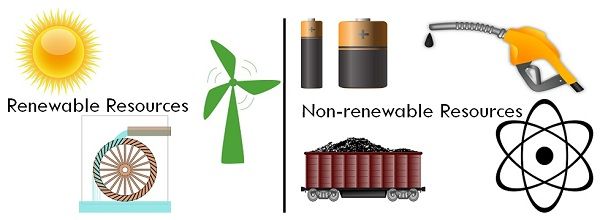 These natural resources are classified into two categories, i.e. renewable and non-renewable resources. In the first category, all those resources which are available in infinite quantity and can be used again and again are included, while in the second type, the resources which are limited and will extinct in future are considered.
These natural resources are classified into two categories, i.e. renewable and non-renewable resources. In the first category, all those resources which are available in infinite quantity and can be used again and again are included, while in the second type, the resources which are limited and will extinct in future are considered.
Living organisms are blessed with gifts of nature, as it made our earth, the best place to reside. The thought of life would be unimaginable, without the resources provided by nature such as plants, food, sunlight, air, water, fuels, etc. To make our life easier and better, these resources play a crucial role because we use these resources as a form of energy in our day to day life for different activities, like we use petrol in our motorbikes, electricity in our homes or offices, food and water to survive, etc.
So, take a look at the article, in which we have presented all the differences between renewable and non-renewable resources.
Content: Renewable Resources Vs Non-renewable Resources
Comparison Chart
Definition of Renewable Resources
As the name signifies, renewable resources are the natural assets, that can be replenished in the future. The resources can be used over and over again, as they can be revived naturally. Biomass, oxygen, water, sunlight are some of the common examples of renewable resources.
These resources are replaced at a rate faster than or equal to the rate of usage, in the sense that the resources regenerate itself by the time it is consumed. This type of resources are enduring in nature, which never gets extinct, i.e. they are believed to have constant supplies over the years and includes solar energy, wind energy, hydroelectricity, etc. However, there are some renewable resources which revive itself at a sustainable rate like wood, oxygen, bio-energy, oils from plants and seeds, etc.
Definition of Non-renewable Resources
Non-renewable resources represent the resources which do not revive itself at a substantial scale, for enduring economic extraction in the specified period. These natural resources are available in finite quantity, which is once used, cannot be replenished. Examples of non-renewable resources are coal, fossil fuel, crude oil, nuclear energy, etc.
We are greatly dependent on non-renewable resources as they are the main source of energy to us. These are found deep inside the earth and take centuries to regenerate itself. Hence, the rate of consumption of non-renewable resources is greater than the rate of reproduction, by natural process and so, there is always a fear of depletion of such resources due to excess use.
Key Differences Between Renewable and Non-renewable Resources
The points given below are substantial so far as the difference between renewable and non-renewable resources are concerned:
- Renewable resources are the resources which can be revived, through the natural process, over time. On the other hand, non-renewable resources are the natural resources which are not going to be replenished, shortly.
- Renewable resources do not become extinct easily, and so they are sustainable in nature. Conversely, non-renewable resources deplete over time, i.e. they are exhaustible in nature, which can be ended when they are prone to large scale consumption.
- Renewable resources exist in nature in infinite quantity, but non-renewable resources are present in limited quantity.
- Renewable resources emit less carbon as compared to non-renewable resources. Hence, they are pollution free and environment-friendly.
- As renewable resources are available to us in abundance, they are relatively cheaper than non-renewable resources, which are costlier. However, the maintenance cost of renewable resources is higher than that of non-renewable resources.
- The renewable resources regenerate/reproduce itself, faster than it is used up by the living organisms. In contrast, the non-renewable resources either take centuries to regenerate itself, or they get extinct, so the scale at which it is regenerated is lower than that of its consumption.
Conclusion
Suppose a life without electricity, mobiles, bikes or cars, computers, food, clothes, water, etc. it is not even imaginable because we will not be able to survive. Both renewable and non-renewable resources are the assets of nature, to mankind, which must be used or consumed with much care and zero wastage, because once they are exhausted, it will take years and years to get them back. All the human beings are highly dependent on these resources, as they help us in making our life smooth and so we should conserve them for future.








sam says
This was very useful
Ashmit says
Every difference is available ! thanks, reducing search time
Palak prasad says
It is very useful for me as it helped in my project
james says
this was very helpful
karmapluss says
Great information, Thanks for sharing this informative blog with us. Keep sharing!!
laylay says
this was very helpful thank you so much i might pass on my test
Shiloh says
Thanks for all the info